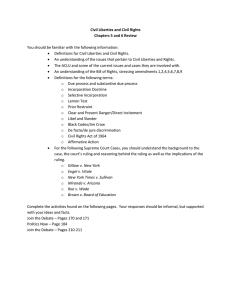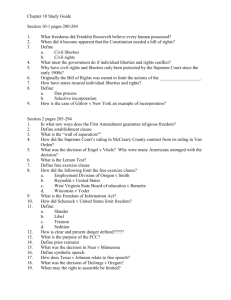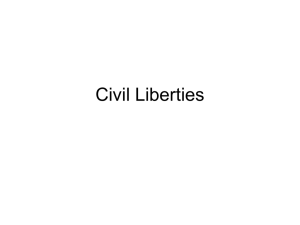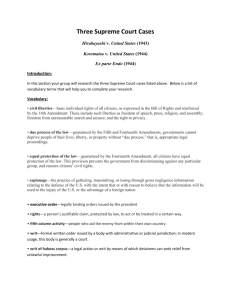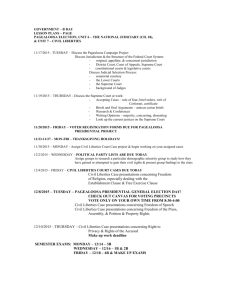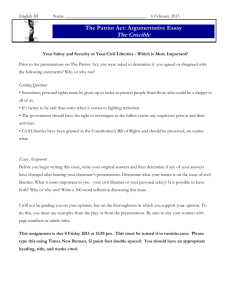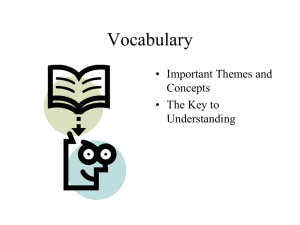Civil Liberties Supreme Court Research Paper (1)
advertisement
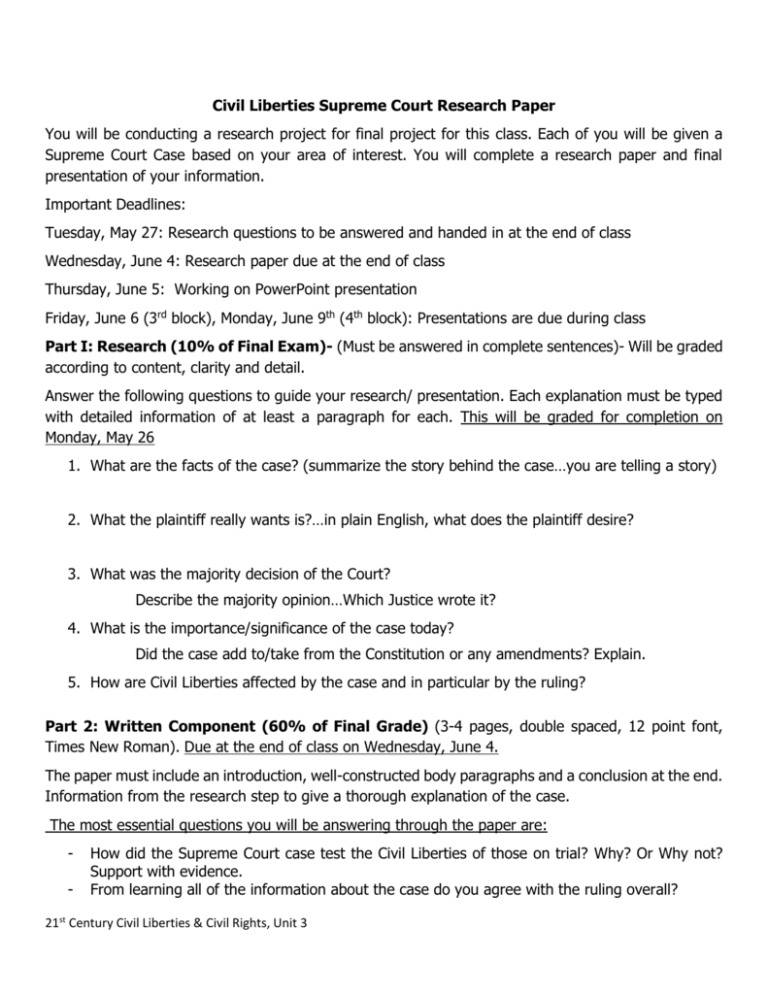
Civil Liberties Supreme Court Research Paper You will be conducting a research project for final project for this class. Each of you will be given a Supreme Court Case based on your area of interest. You will complete a research paper and final presentation of your information. Important Deadlines: Tuesday, May 27: Research questions to be answered and handed in at the end of class Wednesday, June 4: Research paper due at the end of class Thursday, June 5: Working on PowerPoint presentation Friday, June 6 (3rd block), Monday, June 9th (4th block): Presentations are due during class Part I: Research (10% of Final Exam)- (Must be answered in complete sentences)- Will be graded according to content, clarity and detail. Answer the following questions to guide your research/ presentation. Each explanation must be typed with detailed information of at least a paragraph for each. This will be graded for completion on Monday, May 26 1. What are the facts of the case? (summarize the story behind the case…you are telling a story) 2. What the plaintiff really wants is?…in plain English, what does the plaintiff desire? 3. What was the majority decision of the Court? Describe the majority opinion…Which Justice wrote it? 4. What is the importance/significance of the case today? Did the case add to/take from the Constitution or any amendments? Explain. 5. How are Civil Liberties affected by the case and in particular by the ruling? Part 2: Written Component (60% of Final Grade) (3-4 pages, double spaced, 12 point font, Times New Roman). Due at the end of class on Wednesday, June 4. The paper must include an introduction, well-constructed body paragraphs and a conclusion at the end. Information from the research step to give a thorough explanation of the case. The most essential questions you will be answering through the paper are: - How did the Supreme Court case test the Civil Liberties of those on trial? Why? Or Why not? Support with evidence. From learning all of the information about the case do you agree with the ruling overall? 21st Century Civil Liberties & Civil Rights, Unit 3 A work cited page with MLA citations must be included as well as in text citations within the paper. (3 sources needed) Suggested structure for paper: Introduction: Provides a brief explanation of the case and its importance to all Americans. It should also have well thought out answers to both essential questions. Body Paragraphs: The first 2 paragraphs should give a detailed explanation of the court cases which includes the information found during the research stage as well as any other important information which may include public reaction to the court ruling and its effective on American society in the future. The next two body paragraphs should include an in-depth analysis of the Supreme Court Case decision. Provide at least two detailed reasons why you agree or disagree with the decision made by the Supreme Court. Conclusion: The conclusion should definitively state whether or not you agree or disagree with the court ruling and provide clear and concise reasons why. Part 3: Presentation (30% of Final Exam) (3-5 minutes long and at least 10 informational slides.) Presented during class on June 6th (3rd block) or June 9th (4th block) Through a multimedia presentation students must explain the most pertinent parts of the case, and also explain what Civil Liberties were being putting on trial and weather they agree or disagree with the ruling after doing all the research. A work cited page must be included at the end of the presentation as well. 21st Century Civil Liberties & Civil Rights, Unit 3 Recommended Case Studies Rights of the Accused Mapp v. Ohio 1961—prevents illegal search and seizure Gideon v. Wainwright 1963—guarantees a lawyer Miranda v. Arizona 1966—rights must be read before questioning Escobedo v. Illinois 1964—right to a lawyer during questioning Furman v. Georgia 1972—death penalty Gregg v. Georgia 1976—death penalty Roper v. Simmons 2005—bans death penalty for juveniles Freedom of Speech/Press Roth v. U.S. 1957—obscene speech Texas v. Johnson 1989—flag burning Tinker v. Des Moines 1969—symbolic speech Reno v. ACLU 1997—obscene speech and juveniles Brandenburg v. Ohio 1969—cannot limit inflammatory speech unless it incites violence Gitlow v. New York 1925—anti-government speech Hazelwood School District v Kuhlmeier, 1988Freedom of Press (School Newspaper) Freedom of Religion Engle v. Vitale 1962—bans prayer in school Abington v. Schempp 1963—bans Bible readings in school Everson v. Board of Education 1947—allows for reimbursement of bussing money for parochial students Advocacy 1960’s counter culture Pro-life/family planning movement Feminism movement American Civil Liberties Union Barriers Patriot Act, Espionage Act Red Scare, Internment North Carolina Amendment 1 Powell v. Alabama 1932 & Patterson v. Alabama 1935—Scottsboro boys, due process, legal counsel Charles Stinney—youngest execution in the U.S. Communications Decency Act o Ginsberg v. New York 1968 o F.C.C. v. Pacifica Foundation 1978 o Renton v. Playtime Theatre Inc. 1986 Other Supreme Court Cases: o Regents of the University of California v Bakke, 1978- Affirmative Action 21st Century Civil Liberties & Civil Rights, Unit 3 o Dred Scott vs. Sandford, 1857- Slavery property Additional Case Studies Rights of the Accused Powell v. Alabama 1932 & Patterson v. Alabama 1935—Scottsboro boys, due process, legal counsel Betts v. Brady 1942—indigent defendants and counsel Sacco and Vanzetti case—influence of prior history Coker v. Georgia 1977—no death penalty for rape In Re Gualt 1967—juveniles and due process O’Connor v. Donaldson 1975—cannot be indefinitely detained if mentally ill Strauder v. West Virginia 1879—cannot be excluded from a jury based on race Freedom of Speech/Press Stromberg v. California 1931—wearing of red flags West Virginia Board of Education v. Barnette 1943—cannot be forced to say the Pledge of Allegiance Yates v. U.S. 1957—protects radical speech New York Times v. Sullivan 1964—actual malice and defamation Hannegan v. Esquire 1946—cannot withhold mail based on what it says Hustler v. Falwell 1982—obscene speech Near v. Minnesota 1931—limits restrictions on free speech RAV v. City of St. Paul 1992—public displays are allowed Schenck v. U.S. 1919—Espionage Act doesn’t violate the 1st Amendment Curley v. NAMBLA 2000—protection of inflammatory speech Freedom of Religion Scopes Trial—evolution vs. creationism in schools Illinois ex rel McCollum v. Board of Education 1948—no religious instruction in public schools Lee v. Weisman 1992—no prayer at school ceremonies Minersville School District v. Gobitis 1940— saluting the flag West Virginia State School Board v. Barnette 1943—saluting the flag 21st Century Civil Liberties & Civil Rights, Unit 3

